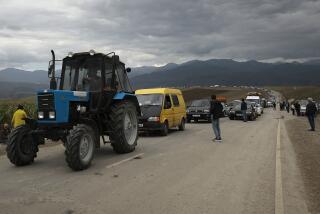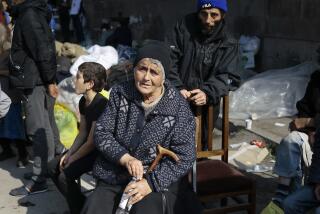A Long History of Suffering Has Steeled Armenia, So It Will Survive and Rise Again
Today Mt. Aragats stands silently in anguish and in grief.
This snow-capped peak, the highest in Soviet Armenia, has been struck once again with tragedy as the ancient regions on its northern flank have become fields of death and graves of devastation.
The earthquake that crushed northern Armenia last week continues to take its toll in human life and physical destruction. But, for the Armenians, this natural disaster is only the continuation of a long history of suffering.
Leninakan, the republic’s second-largest city, just a week ago was a thriving commercial metropolis of 200,000. Known in old times as Giumri and under czarist rule as Alexandropol, Leninakan is strategically located on modern Armenia’s border with Turkey. As such, the city has often borne witness to several rounds of human suffering. For example, after the Turkish genocide of the Armenians in 1915, many of the survivors of the massacres came to the city as refugees.
Leninakan’s woes continued this year as it opened its arms on the eve of the earthquake to a new flow of refugees--this time from the neighboring Soviet republic of Azerbaijan, where thousands of Armenians have been expelled from their homes as part of the Azerbaijani reaction to an Armenian quest to unite the district of Nagorno-Karabakh with Armenia.
But, aside from its humanitarian past, Leninakan was a beautiful city and a center of culture. A town of expansive verdant parks, old black-stone churches and quaint shopping malls, Leninakan was famous for its good-humored residents, the grand arched doors of its central residential district and a deep devotion to instilling national pride in new generations. It was home to the first Armenian university in modern times, which was established in 1920 in the days of the independent republic of Armenia. The churches, schools and children in the park are no more.
The earthquake also devastated Kirovakan, the third-largest city of Soviet Armenia. Like Leninakan, this city is surrounded by small villages and an agriculture-based economy. Kirovakan, however, is in a heavily industrial area with several chemical plants,which have come under sharp criticism of late for their toxic emissions. The pollution is especially offensive because this city of 150,000 is also the gateway to Armenia’s Lori region in the north, with beautiful wooded mountains and lush green hamlets so rare in the rest of Armenia.
Finally, Spitak, the main town on the road between Leninakan and Kirovakan, rests in total ruin in the shadow of Mt. Aragats. Reports say that Spitak is now rubble, that the buildings have been leveled, that there are few survivors. The workers there were in their factories, the peasants on their plots, the children behind their desks when the ruthless force of nature ravaged the buildings, crushed the children and orphaned the land.
The agony of Leninakan, Kirovakan, Spitak and all the other towns and villages of the country is shared today by Armenians worldwide.
For the Armenians, 1988 has been a year of great expectations and high hopes, a time of national struggle for the territorial integrity of the homeland and for greater democratic rights in Soviet society. In the process, though, the stamina of the Nagorno-Karabakh movement has not been left unchallenged. The national tragedy of anti-Armenian massacres and forced expulsions has now been joined by the terrible dimensions of natural tragedy.
Armenian history has indeed been marked by such misfortune, but it has equally been characterized by an ability to survive and rebuild. Today the Armenians are again determined to overcome. The response of the civilized world to Armenia’s distressed call for help will in large measure shape the scope and pace of that recovery.
Mt. Aragats is used to the pain and suffering. Every day it looks a few miles to the west to greet Mt. Ararat, now separated by the Turkish border that divides old Armenia. Ararat, too, has seen its share of misery, from the great flood to the genocide.
Yet nothing, neither sword nor storm, has ever killed the spirit of Armenia. Today the children of Ararat will demonstrate once more how the phoenix rises, this time from the ruins and ravages of Soviet Armenia.
More to Read
Sign up for Essential California
The most important California stories and recommendations in your inbox every morning.
You may occasionally receive promotional content from the Los Angeles Times.










